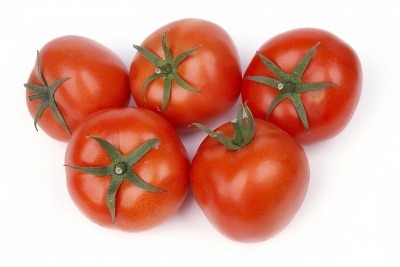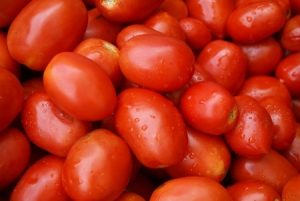
The tomato (Solanum lycoperiscum Mill.) ranks as a top summer food – salads, salsas, sauces and other alliterative terms associated with it readily come to mind. In fact it is one of the most popular vegetables we know of and a key integral component of many people’s diet. It is widely consumed both as a fresh fruit and is versatile enough to be incorporated into a number of processed foods. I’m sure we have all consumed tomato foods in the form of juice, a puree, ketchup, paste and as salsa.
The tomato offers a number of beneficial effects to human health because of its high content in natural antioxidants including carotenoids (especially lycopene), phenolic compounds, vitamins, etc. (Gomez-Romero et al., 2007; 2010).
What Do We Admire About Tomato ?
Research at the North Carolina State University demonstrated the very characteristics that make for good fresh tomato eating experience. What are they ? We probably know this ! The key attributes in order are colour: a great red, juiciness when sliced which corresponds to some degree with flavour, then size, some seeds and a similar rating for firmness. Many consumers are disappointed if their tomato does not measure up to these characteristics. The research group used conjoint analysis which is a technique to collect large bodies of date from consumers is a manner reflecting a real life marketing setting. This was combined with qualitative insights from focus groups which yielded information on purchasing behaviour and consumption (Oltman et al., 2014).
The Flavour Of Tomato
Previous research on the flavour of tomatoes shows it have a sweet-sour taste with a variety and complexity of aromatics such as fruity, green or floral notes (Baldwin et al., 2008). In fact, 400 volatiles have been found but less than 20 are considered important enough to contribute to its distinctive flavour based on odour analysis. The important compounds are acetone, methanol, ethanol, l-penten-3-one, hexanal, cis-3-hexenal, 2- and 3-methylbutanol, trans-2-hexenal, trans-2-heptenal, 6-methyl-5-hepten-2-one, cis-3-hexenol, geranylacetone, 2-isobutylthiazole, and β-ionone (Buttery et al., 1987; Tandon et al., 2000). The sweetness comes from fructose whilst citric and malic acid are the sour notes.

Harvesting Tomato And Postharvest Issues
Commercial harvesting practices and postharvest handling procedures for fresh tomatoes intended for market also play a vital role in tomato flavour. Postharvest abuses, such as the harvesting of immature fruit, various forms of mechanical injury during sorting and packing, and incorrect temperature management have been related to significant changes of the aroma volatile profiles and altered flavour perception (Sargent et al., 1997; Moretti et al., 1998). Evidence for the adverse effects of low temperature storage on tomato flavour is available (Kader et al., 1978; Stern et al., 1994; McDonald et al., 1996).
Postharvest treatments such as short-term ozone treatment and UV-B and UV-C irradiation, have been reported to be useful in reducing excessive tomato softening and enhancing antioxidant capacity (Maharaj et al., 1999; Rodoni et al., 2010; Liu et al., 2011; Obande et al., 2011).
It’s often stated that keeping the tomato with its stalk in important for flavour. Certainly, vine ripened tomatoes have a better quality in flavour than tomatoes ripening in a room, probably because sugar content is lower (Stevens et al., 1977; Jones and Scott, 1983).
Tomato Pomace And What Can We Make Of It?
Tomato processing generates a lot of waste. We’ve talked about what to do with the seeds elsewhere but a lot of tomato skin for example is generated as well. Apparently, 4% of the weight of tomato is pomace which is the general term for the residue left after processing (Del Valle et al., 2006). The pomace contains the skin which is often dried and macerated as well as the seeds (Tadeu-Pontes et al., 1996).
If you consider the skin, there are some useful components that could be extracted. Lycopene is such a material. It is the key component of colour in the tomato as well as being a valuable functional ingredient that has significant health benefits. One of them is it is a highly potent antioxidant (Kaur et al., 2005). We know from many nutritional research papers that diets high in lycopene reduce the risk of developing particular cancers because it is a potent compound for mopping up free radicals. Particular cancers that are reduced include prostate cancer, intestinal cancers and pancreatic cancer (Johnson, 2000).
References
Baldwin, E.A., Scott, J.W., Einstein, M.A., Malundo, T.M.M., Carr, B.T., Shewfelt, R.L., Tandon, K.S.(1998) Relationship between sensory and instrumental analysis for tomato flavor. J Am Soc. Hort Sci. 123 pp. 906–15 (Article).
Buttery, R., Teranishi, G., Ling, L.C.,(1987) Fresh tomato aroma volatiles: a quantitative study. J. Agric. Food Chem. 35, pp. 540–544.
Del Valle, M., Camara, M., & Torija, M.-E. (2006). Chemical characterization of tomato pomace. Journal of the Science of Food and
Agriculture, 86, pp. 1232–1236.
, , , . (2007) Analytical determination of antioxidants in tomato: typical components of the Mediterranean diet. J. Sep. Sci. 30(4) pp. 452–61.
, , . (2010) Metabolite profiling and quantification of phenolic compounds in methanol extracts of tomato fruit. Phytochemistry 71(16) pp. 1848–64
Johnson, E. J. (2000). The role of lycopene in health and disease. Nutrition in Clinical Care, 3, pp. 35–43.
Jones, R.A., Scott, S.J. (1983) Improvement of tomato flavor by genetically increasing sugar and acid content. Euphytica 32 pp. 845–55.
Kader, A.A., Morris, L.L., Stevens, M.A., Albright-Holton, M. (1978) Composition and flavor quality of fresh market tomatoes as influenced by some postharvest handling procedures. J. Amer. Soc. Hort. Sci. 103(1) pp. 6-13
Kaur, D., Sogi, D. S., Gary, S. K., & Bawa, A. S. (2005). Flotation-cumsedimentation system for skin and seed separation from tomato pomace. Journal of Food Engineering, 71, pp. 341–344 .
Liu, L.H., Zabaras, D., Bennett, L.E., Aguas, P., Woonton, B.W., (2009) Effects of UVC, red light and sun light on the carotenoid content and physical qualities of tomatoes during post-harvest storage. Food Chem. 115, pp. 495–500.
Liu, C., Han, X., Cai, L., Lu, X., Ying, T., Jiang, Z. (2011) Postharvest UV-B irradiation maintains sensory qualities and enhances antioxidant capacity in tomato fruit during storage. Postharvest Biology and Technology 59, pp. 232–237.
Maharaj, R., Arul, J., Nadeau, P. (1999) Effect of photochemical treatment in the preservation of fresh tomato (Lycopersicon esculentum cv Capello) by delaying senescence. Postharvest Biology and Technology 15, pp. 13–23.
Maul, F., Sargent, S.A., Sims, C.A., Baldwin, E.A., Balaban, M.O., Huber, D.J., 2000. Recommended commercial storage temperatures affect tomato flavour and aroma quality. J. Food Science 65, pp. 1228–1237.
McDonald, R.E., McCollum, T.G., Baldwin, E.A. (1996) Prestorage heat treatments influence free sterols and flavor volatiles of tomatoes stored at chilling temperature. J. Amer. Soc. Hort. Sci. 121(3) pp. 531-536.
Moretti, C.L., Sargent, S.A., Huber, D.J., Calbo, A.G., Puschmann, R. (1998) Chemical composition and physical properties of pericarp, locule and placental tissues of tomato fruit with internal bruising. J. Amer. Soc. Hort. Sci. 123(4) pp. 656-660.
Obande, M.A., Tucker, G.A., Shama, G., 2011. Effect of preharvest UV-C treatment of tomatoes (Solanum lycopersicum Mill.) on ripening and pathogen resistance. Postharvest Biology and Technology 62, pp. 188–192.
Oltman, A.E., Jervis, S.M. Drake, M.A. (2014) Consumer Attitutes and Preferences for fresh market Tomatoes. J. Food Sci., 79 (10) S2091-S2097
Rodoni, L., Casadei, N., Concellón, A., Chaves, A.R., Vicente, A.R., 2010. Effect of short-term ozone treatments on tomato (Solanum lycopersicum L.) fruit quality and cell wall degradation. J. Agricultural and Food Chemistry 58, pp. 594–599.
Sargent, S.A., Maul, F., Moretti, C.L., Sims, C.A. (1997) Harvest maturity, storage temperature and internal bruising affect tomato flavor. In: Proc. 1997 Florida Tomato Institute, University of Florida, IFAS. pp. 22-24.
Stern, D.J., Buttery, R.G., Teranishi, R., Ling, L., Scott, K., Cantwell, M. (1994) Effect of storage and ripening on fresh tomato quality, Part I. Food Chem. 49 pp. 225-231.
Stevens, M.A., Kader, A.A., Albright-Holton, M., Algazi, M. (1977) Genotypic variation for flavour and composition in fresh market tomatoes. J Am Soc Hort Sci 102 pp. 680–9.
Tadeu-Pontes, M. A., Carvalheiro, F., Roseiro, J. C., & Amaral-Colloco, M. T. (1996). Evaluation of product composition profile during an
extrusion based process of tomato pomace transformation. Agro-FoodIndustry Hi-Tech, May/June, pp. 39–40
Tandon, K.S., Baldwin, E.A., Shewfelt, R.L., (2000) Aroma perception of individual volatile compounds in fresh tomatoes (Lycopersicon esculentum, Mill.) as affected by the medium of evaluation. Postharvest Biol. Technol. 20, pp. 261–268.
Leave a Reply